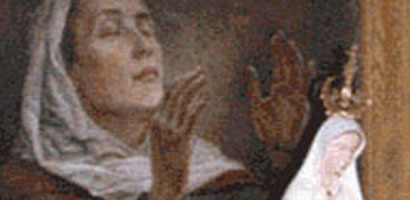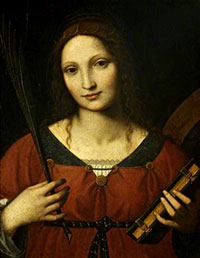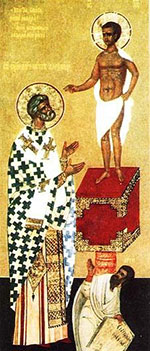 There's a saint for everyone, and families are no different. Here are a few noteworthy examples for your family to learn more about.
There's a saint for everyone, and families are no different. Here are a few noteworthy examples for your family to learn more about.
There is the familiar and beloved St. Joseph, foster father of Jesus, and St. Francis of Assisi, who's on everyone's minds these days with the election of Pope Francis.
But go beyond the obvious: Some of these saints led treacherous lives and died either because of family struggles or they gave their lives to protect their families.
Some had difficult marriages or suffered from domestic abuse, some grieved the loss of children, and some were killed by their in-laws. And you thought your family had issues...
Patron saints of families
— St. Joseph: Feast day, March 19
— St. Francis of Assisi: Feast day, Oct. 4
— St. Maximiliam Kolbe: Feast day, Aug. 14
Patron saint of dysfunctional families
— St. Eugene de Mazenod: Grew up with parents who fought constantly amid interference from his grandmother and a neurotic maternal aunt, who never let his father forget that they brought the money to the family. His parents' eventual divorce – very unusual for the late 18th century – and exile from the French Revolution, left him mostly on his own growing up amid the idle rich. Had a mystical experience at the foot of a cross on Good Friday 1807, became a priest, ministered to the sick, prisoners, the poor and the overlooked young, and went on to found the Oblates of Mary Immaculate. Feast day, May 21.
Patron saints of large families
— St. Margaret of Scotland: While fleeing the invading army of William the Conqueror in 1066, her family's ship wrecked on the Scottish coast. They were assisted by King Malcolm III Canmore of Scotland, whom Margaret married in 1070. They had eight children including two saints. Founded abbeys and used her position as queen of Scotland to work for justice and improved conditions for the poor. Feast day, Nov. 16.
— St. Adelaide of Burgundy: Promised at age 2 in an arranged marriage as part of a treaty, then married at 16 to the king of Italy and soon widowed after her husband was probably poisoned by his successor to the throne. The successor ordered Adelaide to marry his son; she refused and was jailed. The German king Otto the Great freed her, they married and reigned together for 20 years. When her second husband died, her step-son and her in-laws mistreated her. Feast day, Dec. 16.
—St. Clotilde: Married young to King Clovis of the Salian Franks while he was still a pagan; she brought him to the faith in 496. They had three sons. Following Clovis's death in 511, her sons fought for years over the kingdom. To escape the constant murder and intrigue, she retired to Tours, France, where she spent her remaining years caring for the poor and sick. Feast day, June 3.
—St. Dagobert II: When his father, the king of Austrasia, died his throne was stolen and Dagobert was kidnapped and exiled to England, where he married an English princess. Eventually recalled to Austrasia for a supposed reunion, he died in a "hunting accident" that most considered a murder. Feast day, Dec. 23.
— Blessed Dorothy of Montau: Married at age 17 to a wealthy swordsmith who abused her. Bore nine children, all but one of whom died young. Became a nun after her husband's death and had such a great devotion to the Blessed Sacramant that the Eucharist "agitated her like boiling water; had she been allowed, she would willingly have torn the host from the priest's hands to bring it to her mouth..." Feast day, June 25 or Oct. 30.
— Blessed Ivetta of Huy: Born to family that was wealthy but indifferent to the faith. Forced into an arranged marriage at 13. Mother of three, though one died in childhood. Widowed at 18. She turned away all suitors to care for lepers for 11 years while she raised her children. Had an ongoing dispute with her father over her charitable spending, which he considered excessive. Feast day: Jan. 13.
— St. Leonidas of Alexandria: Father of seven sons, the eldest of whom was the philosopher Origen, whom he raised and taught. Philosopher and rhetorician. Imprisoned and beheaded in Egypt in 202. Feast day: April 22.
— St. Nicholas of Flüe: Soldier who distinguished himself in combat; reported to have fought with a sword in one hand, a rosary in the other. At age 30 he married Dorothy Wiss and they had 10 children. Became a hermit, and was reported to have had the gifts of prophecy and of inedia (surviving for 19 years solely on Holy Communion). Feast day: March 21.
—St. Vladimir of Kiev: Pagan who had seven wives, established temples, and participated in idolatrous rites, possibly involving human sacrifice, before converting to Christianity around 987. He was baptized, took the patronal name Basil, then ordered the Christian conversion of his domains, Kiev and Novgorod. Expanded education, judicial institutions, and aid to the poor. Feast day: July 15.
— Sources: www.saints.sqpn.com and www.catholiconline.com
The start of school is nearly here, and for students, parents and teachers, it’s the perfect opportunity to reflect and pray that the coming months will be fruitful and fun for everyone. The saints are always there to help us on our journey, so here are three saints for you to consider as the 2023-’24 school year dawns:
St. Catherine of Alexandria (c. 287-305)
Feast day: Nov. 25 Catherine is thought to have been born to a noble family in Alexandria, Egypt. Through a vision, this scholarly young woman converted to Christianity and began evangelizing others, including the wife of the pagan emperor who was persecuting Christians. According to legend, after she defied the emperor and refuted philosophers brought in to test her faith, she was imprisoned and tortured.
Catherine is thought to have been born to a noble family in Alexandria, Egypt. Through a vision, this scholarly young woman converted to Christianity and began evangelizing others, including the wife of the pagan emperor who was persecuting Christians. According to legend, after she defied the emperor and refuted philosophers brought in to test her faith, she was imprisoned and tortured.
She was put on a rotating spiked wheel; when it broke, she was beheaded. She is venerated as the Great Martyr St. Catherine in the Orthodox tradition and her voice was among those heard by St. Joan of Arc. Today, she is known as the namesake of a monastery at Mount Sinai that claims to be the oldest in the world. She is the patron saint of wheelwrights, and also a patron saint of teachers, jurists, philosophers, students and teachers.
St. Thomas Aquinas (1225-1274)
Feast day: Jan. 28
 Thomas so shocked his noble Italian family when he entered the Dominicans about 1244 that his brothers kidnapped him from the Dominicans, took him to the family’s castle, and at one point even sent a woman to seduce him – whom Thomas drove out by brandishing a poker from the fireplace. But he would not yield, and studied under St. Albert the Great, becoming a master of theology in 1256. As a priest, he showed great reverence for the liturgy and skill as a homilist.
Thomas so shocked his noble Italian family when he entered the Dominicans about 1244 that his brothers kidnapped him from the Dominicans, took him to the family’s castle, and at one point even sent a woman to seduce him – whom Thomas drove out by brandishing a poker from the fireplace. But he would not yield, and studied under St. Albert the Great, becoming a master of theology in 1256. As a priest, he showed great reverence for the liturgy and skill as a homilist.
In keeping with the Dominican order’s charism for preaching, he strove to bring his own family to a sincere practice of the faith, and largely succeeded. For the rest of his brief life, the “dumb ox,” as he was dubbed, taught, preached and wrote, producing the monumental “Summa Theologica.” The 13th century theologian showed that the Catholic faith is in harmony with philosophy and all other branches of knowledge. His thinking became enormously influential in later centuries and he was named a Doctor of the Church in 1567. In 1965, the Second Vatican Council taught that seminarians should learn “under the guidance of St. Thomas,” in order to “illumine the mysteries of salvation as completely as possible.” He is also a patron saint of academics, chastity, colleges and universities, Catholic schools and theologians.
St. Peter of Alexandria (died 311)
Feast day: Nov. 26
 Born in Alexandria, Egypt, Peter headed its catechetical school before being named bishop-patriarch in 300. In his early Church history, Eusebius called Peter an excellent teacher. Peter’s own theological writings were cited in a fifth-century dispute over Christ’s divinity and humanity. Peter fought two heresies, Arianism and Origenism, and for much of his episcopate encouraged his people to remain Christian in the face of Emperor Diocletian’s persecutions.
Born in Alexandria, Egypt, Peter headed its catechetical school before being named bishop-patriarch in 300. In his early Church history, Eusebius called Peter an excellent teacher. Peter’s own theological writings were cited in a fifth-century dispute over Christ’s divinity and humanity. Peter fought two heresies, Arianism and Origenism, and for much of his episcopate encouraged his people to remain Christian in the face of Emperor Diocletian’s persecutions.
When he eventually went into hiding, Alexandria experienced a schism, and when a new emperor renewed Christian persecutions, Peter was seized and summarily executed. He was the last Christian martyred in Alexandria by civil authorities. His instructions on how to receive “lapsed” Christians who had denied their faith back into the Church were adopted by the entire Eastern Church. Although his feast day in the Western tradition is no longer a part of the Roman Catholic Church’s universal calendar, he remains especially beloved among Catholic and Orthodox Christians of the Egyptian Coptic tradition. He is also a patron saint of Egypt.
— Catholic News Service and Catholic News Agency

